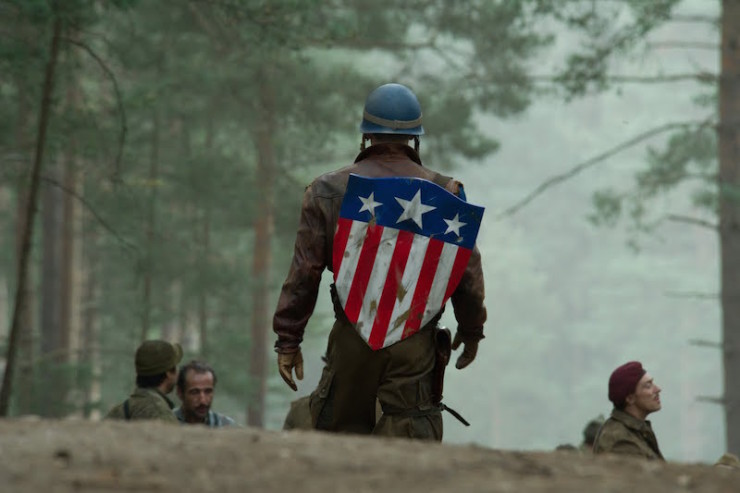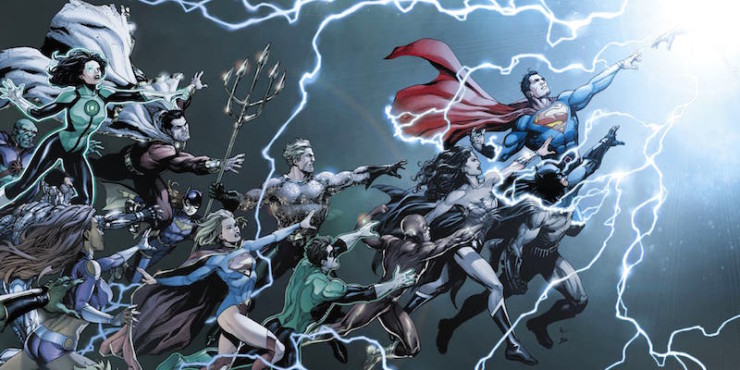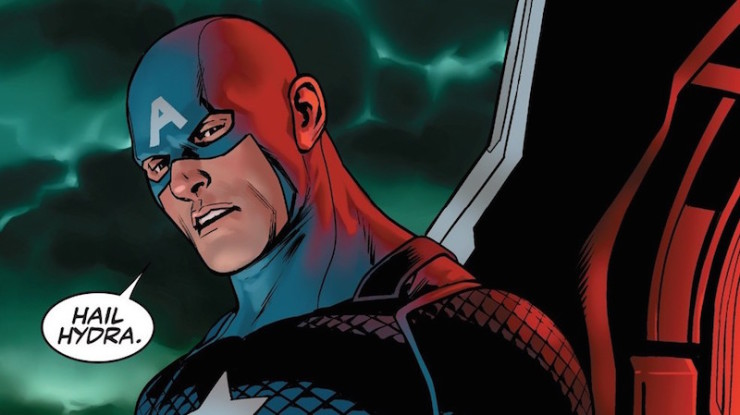It’s been an interesting 24 hours in mainstream comics. Both Marvel and DC have made massive changes to big parts of their respective universes, and the comics internet is still reeling from both. Neither change has gone down particularly well—with many readers crying foul over what they perceive as an intentional misdirect or a cheap gimmick—but both tell us an awful lot about the tensions inherent in writing mainstream comics right now.
Let’s start with the Star-Spangled Man with the, it now seems, Insidious Plan. Captain America relaunched yesterday, with a new issue #1 and a new creative team. Jesus Saiz’s artwork has been some of the most consistently impressive in the industry for over a decade; Nick Spencer’s massive ambition and intricate plotting has marked him out as one of the best of the new wave of writers. This is very close to a creative dream team, and it shows: The art is brawny, clean, and expressive, and the script is well-designed and neatly expands Cap’s world. Steve Rogers was, for some time, aged to the point where he couldn’t serve as Captain America anymore and handed the shield off to everyone’s favorite pararescue specialist, Sam Wilson. Now de-aged, Steve is back in the field next to Sam and fellow superheroes Jack Flag and Free Spirit. This is a really smart call because not only does it not undercut SamCap (who’s GREAT, by the way), but it also makes Captain America more of an idea than an individual. Seeing the paragon of virtue represented not by one man, but by a diverse group, is smart and, honestly, pretty inspiring.
Which is why the ending is so shocking.
While extracting Doctor Erik Selvig (Hi, Stellan Skarsgård! Welcome to comics!) from the custody of Baron Zemo, Cap’s life is saved by Jack Flag. He rewards the young man by apologizing and hurling Jack out of a plane to his apparent death. Then he says two words: “Hail Hydra.”
Twenty-four hours after publication, Nick Spencer has received death threats, the issue has gotten massive press coverage. and a lot of people are very, very unhappy. Spencer has been accused of destroying a multi-decade legacy, of rendering Cap meaningless as a character, and of insulting the memory and ideals of the two Jewish comic creators who gave us Steve in the first place.
That last charge we’ll come to in a moment. The first two really don’t stick because, well, firstly Disney just made a billion dollars from the third Captain America movie so Cap 4: The Nazi Years isn’t even in the room, let alone on the table. To be clear, there is no way Cap is going to be a Nazi forever. That would destroy an immensely bankable movie franchise. Not to mention be complete anathema to a character defined by his opposition to those ideals. Spencer’s run will certainly explore the idea, but there’s no way this will stick.

Secondly, this—like very nearly every run on very nearly every Western comic that’s gone before it—is going to have little or no long-term impact on the character. Batman used to be paralyzed. Green Arrow used to be dead. She-Hulk… well, She-Hulk has always been fabulous, her wardrobe has just improved. All longform comics, especially superhero comics, eventually return to an equilibrium. They’re a reset button with speech bubbles and an issue number, and this run is no exception.
So, looked at that way, no, this run has not destroyed a multi-decade legacy. It also hasn’t rendered the character meaningless in the slightest. Rather, the views he expresses here seem designed, as the run goes on, to bring what Cap truly is into even sharper focus. That’s why there’s the larger cast, too: because Captain America is an ideal, not an individual. With Spencer taking Cap into dark waters, it looks like the extended cast will be carrying that ideal by themselves for a while.
Which just leaves us with the charge of insulting the memory of his creators. And that’s harder to shake off.
The MCU hasn’t made many mistakes, but arguably one of its biggest is tying Hydra irrevocably to the Nazis. Metatextually, it makes perfect sense to make Cap a World War II veteran because it grounds the movies, and him, in a way that’s helped them immensely. Cap’s role as part of the Greatest Generation has powered him towards a level of fan engagement and investment that’s not been seen before.
Cap is in his seventh decade as a character, and across that time, there have been evil Cap stories. But he has never essentially sworn loyalty to Hitler before; and by having Cap aligned with Hydra, that’s exactly what he’s doing. So in that way, the twin forces of the immensely successful movies and the constant need to do (temporarily) new things with the character push him, and the readers, down a path a lot of them are going to have very serious problems with.
But does this run insult the memory of Cap’s creators, Joe Simon and Jack Kirby? That’s an impossible question to give a universal answer to, especially with only a single issue in print. Some people will say yes; others will say no; and still more will be uncomfortable, interested, and keep reading. That last group, Marvel are gambling, will be the largest. I know I’m part of it.
And speaking of gambles, DC’s own Hail Mary pass has had less of a direct, visceral response but is arguably a far more complex and, in some ways, more troubling move.
Also released yesterday, DC Universe: Rebirth Special #1 is a special issue that lets lots of genies out of bottles. The long-banned romantic relationships between characters are back, the original Wally West has returned to the DCU, and there are hints of much more to come. Most significantly, the issue reveals that the entire cast has had a decade of their lives stolen by a malevolent unseen force that’s been monitoring them. A force that, at the end of the issue, is revealed to be Doctor Manhattan from Alan Moore and Dave Gibbons’ Watchmen. And he’s preparing to attack again…
This plot will unfold across the next two years in many DC titles, because massive longform continuity is apparently also back. Or, to put it another way: The chances of this ending in two years’ time with the DC heroes all clustered on one side of a cover punching a very large, very naked, and very blue man on the other side?
Pretty high right now.

Alan Moore has, for very good reasons, long been in dispute with DC over a variety of issues, including Watchmen. He’s gone as far as saying on the record that he would prefer the prequel series, Before Watchmen, not happen at all than to be paid for it. It happened anyway. With the decades-long and very public dispute with Moore in mind, tying one of his greatest works to the DC Universe at the atomic level feels, bluntly, like a cheap shot.
In fairness, that may not be the intention. Speaking to The Wall Street Journal, writer Geoff Johns said:
I think Watchmen is a great book, but I don’t think a cynical take on superheroes is the truthful one.
Johns’ reasoning is sound—Watchmen was the grim and gritty superhero story that broke out into the mainstream in the 1980s—but using the series this way feels both dangerously backward-facing and reductive. Mainstream comics have constantly buckled under the weight of metatextual commentary for decades now. With that in mind, a two-year visual fisking of Watchmen’s ideas and motifs seems more likely to exhaust than entertain. That’s even before we get to the frankly weird idea that longform continuity is going to attract new readers, or that this won’t play like an extended attack on a book—and a creator—that simply isn’t needed or warranted. Worse still, laying the blame for the excesses of the New 52 at the feet of Watchmen is a little like blaming the career of Michael Bay on John Woo.
So, Captain America is a Nazi and Doctor Manhattan is probably about to be the DCU’s much more naked version of The Beyonder. Like I say: busy 24 hours.
So what do we do, as readers and fans?
Well, the bad news is, there’s no right answer. The good news is that—death threats, harassment, and actual violence set firmly aside—there’s no real wrong answer. Read what you love, step away from things you don’t, and always be open to new ideas. Because as long as mainstream superhero comics are being produced, there will always be something new, and there will always be these choices to make.
And in the mean time? I recommend that you read Princeless. It’s great.
Alasdair Stuart is a freelancer writer, RPG writer and podcaster. He owns Escape Artists, who publish the short fiction podcasts Escape Pod, Pseudopod, Podcastle, Cast of Wonders, and the magazine Mothership Zeta. He blogs enthusiastically about pop culture, cooking and exercise at Alasdairstuart.com, and tweets @AlasdairStuart.










